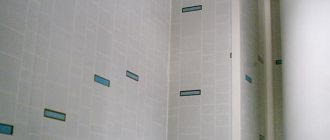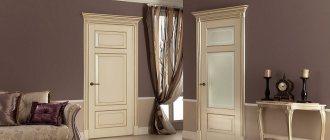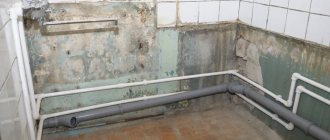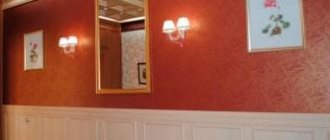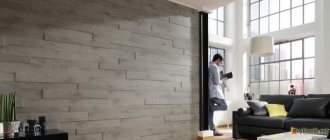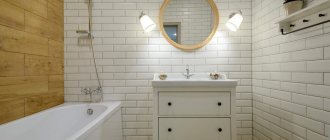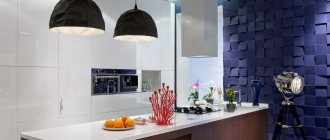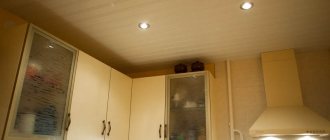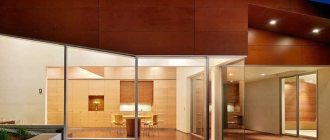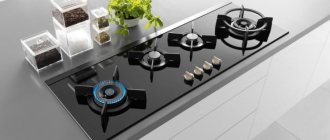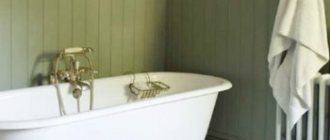Material selection
Plastic panels are rectangular and hollow surfaces with perforations on the inside. And on the front side they have a decorative design - it can be imitation wood or marble, photo printing, 3D image or just a single-color coating . PVC panels have standard dimensions: the length is six meters, and the width can be from ten to twenty-five centimeters.
If you decide to decorate your bathroom with PVC panels, then you need to know that the material has disadvantages, these include:
- easily ignite;
- fragility, they are susceptible to mechanical damage;
- “eat up” space.
At the same time, the range of panels is very wide. When choosing, you can be guided by the main criteria:
- Color. For small rooms, it is better to choose light colors to visually make the space more voluminous.
- Drawing. Small images placed across the canvas will help to visually enlarge a small bathroom. And elongated objects are a good option for a room with low ceilings.
- Strength. The more strength ribs there are, the stronger the material can be considered.
- Relief. If there are roughnesses and protrusions on the canvases, then it will be more difficult to clean such a bathroom.
- Smoothness. If you take a material with uneven surfaces, then after its installation you will see cracks into which dirt and water will constantly get clogged. Therefore, fungus and mold may appear in the room.
- Compound. It must contain carbon, chlorine, hydrogen.
In small apartments it is important to use moisture-resistant boards. Finishing the bathroom with PVC panels will help you hide inelegant pipes and wall imperfections.
What are the panels?
The production technology of polyvinyl chloride is not particularly complex. To make the material, ordinary salt and petroleum products are required. All this is crushed as much as possible to a powder state, then by pressing the viscous melt through a mold.
For strength, moisture resistance and plasticity, specific additives are mixed into the mass. And to get the desired shade, it is painted in different colors.
Material advantages
Compared to other finishing materials, plastic panels have a number of advantages, such as:
- Ease of operation. Due to their light weight, sheets or tiles are fastened quickly and easily, unlike tiling work, which saves time and effort, and installation of plastic panels does not require any specific skills and knowledge, which is undoubtedly a winning option for a non-professional. Anyone can quickly master the technique of working with panels, and you can do without the intervention of a specialist.
- Practicality. Under the structures you can hide any bathroom communications without resorting to additional construction work, and you can also apply a layer of insulation or sound insulation.
- The panels do not require a special surface. If when working with tiles, an important condition is the initial preparation of the walls, then for panels, puttying is not necessary and if the walls themselves are smooth, there is no need to additionally prepare the surface before covering.
- Moisture resistance. Water does not have a harmful effect on polyvinyl chloride, and therefore mold will not form on them.
- Range. The choice of panels is very wide; you can choose a material of any color and shade, both with and without ornament.
- Availability. Plastic panels are a fairly budget option, and do not require any expensive tools, fittings or consumables for installation. And if the decorative surface is damaged, you can always replace it with a new one for a nominal fee.
Also interesting: How to choose and install a siphon for a shower stall?
There are not many disadvantages - first of all, it is poor resistance to mechanical damage. Due to impacts, dents may appear on the plastic, it becomes deformed and loses its appearance.
It is necessary to take into account that to fasten shelves and furniture, holes must be made very carefully, otherwise the sheet will burst along the entire length or width.
Installation tools
If you decide to install plastic panels in the bathroom yourself, then all the necessary materials should be at your fingertips. Therefore, it is worth making the repairs easier for yourself and preparing everything in advance. And you will need, in addition to the plastic panels themselves, the following:
- screwdriver, dowels, screws;
- drill;
- hacksaw;
- bath baseboard;
- triangle, tape measure, pencil;
- plastic moldings;
- sealant and glue.
This list may look slightly different - it all depends on the mounting method . Nowadays, two methods are usually used to secure the sheathing: without a frame and with it.
Preparatory stage
This stage of work is determined, first of all, by the method of fastening the decorative panels. If the frame installation method is chosen, then you can limit yourself to only cleaning the surface from dust and sealing cracks.
If the surface of the wall shows signs of destruction, for example, crumbling plaster, then it should be cleaned of this layer or try to strengthen it with the help of special primers. In the most difficult cases, even plastering may be required.
When choosing an adhesive installation method, higher requirements are imposed on the preparation of the base. Therefore, if there is an old finish, it is completely removed, and the surface is plastered or finished with plasterboard.
We invite you to familiarize yourself with Chemistry for cesspools: chemicals for toilets and cesspools, chemicals, chemicals for cleaning, choosing products
But, regardless of the chosen method of attaching the panels, the base underneath them must be treated with special antiseptic compounds.
Lumber that is planned to be used to create a frame must also undergo appropriate processing, protecting it from infection by microorganisms, deformation and increasing its fire resistance.
Before you cover the bathtub with plastic panels with your own hands, you need to buy it yourself
finishing material
, without forgetting about components and additional accessories, which include: starting strips, decorative moldings, corners,
ceiling plinth
and other products.
Cover the bathtub with plastic panels yourself
You should purchase the required number of panels only from one batch to avoid color mismatch. In this case, you need to take care of 5-10% of the reserve, which is necessary for trimming, finishing non-standard areas and, possibly, for repairs in the future, for example, if a small area is damaged.
The panels must be purchased in advance, at least 2-3 days before installation, and allowed to “rest” in a room whose temperature corresponds to the conditions of the bathroom.
If you decide to glue the panels to the base, you will need to buy glue and the necessary painting tools for applying it. To construct a frame, you cannot do without a drill and a screwdriver, the use of which is especially important if you decide to fasten the material with self-tapping screws - their number will be very large.
You will also need a fine-toothed hacksaw and/or a construction knife for cutting panels, a level, a tape measure or other measuring device.
It is possible that a sealant will also be needed, for example, to seal cracks to prevent water from getting under the skin.
Most often, slatted products are used for finishing, and their installation can be carried out in several options:
- vertically (most common);
- horizontally (in a bathroom, this method is very controversial, especially when using suture material, since water can accumulate at the junction of the panels);
- diagonal.
Cladding with PVC panels
You need to start by calculating the amount of finishing material so that you don’t have to overpay or go to the store for an additional batch. The panels can be mounted both vertically and horizontally, depending on the wishes of the apartment owners. When mounting vertically, the number of panels is calculated as follows: measure the length of the perimeter of the room, subtract the width of the openings and divide by the width of one panel. To the resulting number add 2-3 lamellas in reserve.
For horizontal installation, measure the area of the room minus door and window openings and divide by the area of one panel. Here the margin should be at least 10%, since the consumption of material for trimming increases. Additionally, you need to calculate the number of slats for the sheathing and fasteners. First, the height of the walls is divided by the sheathing pitch, which is usually 0.5 m, and multiplied by the perimeter of the room.
How to attach PVC lining to walls
There are three ways to secure the panels to the wall - using glue, self-tapping screws and clamps. The first method is suitable for very even and smooth walls; glue is used special for PVC, universal “Moment-installation” or “liquid nails”.
Installation of panels with glue
The use of this method simplifies and reduces the cost of the installation process, since there is no need to attach the sheathing. Disadvantages: it is impossible to replace a damaged panel; during subsequent repairs it is difficult to remove the covering from the wall.
Methods for installing PVC panels on walls
Fastening with self-tapping screws is a reliable and convenient option that does not require a perfectly flat surface. To screw in the screws, you definitely need a screwdriver, otherwise the installation process will take a long time. Disadvantages of this method: a wooden frame is better suited for self-tapping screws, so additional time is spent cutting the timber and treating it with an antiseptic.
How to attach plastic panels
The third option is the most optimal. The clamps are conveniently and quickly attached to the sheathing and securely fix the panels to the wall. The lathing is mounted from a metal profile, assembly of the covering is carried out effortlessly. A damaged lamella can be easily replaced with a new one; dismantling the finish also does not take much time.
Installation of PVC panels
During the work, everything should be at hand, so materials and tools for installation are prepared in advance. You will need:
- fine-toothed hacksaw;
- pencil and tape measure;
- level;
- square;
- plastic panels;
- slats or plastic profile;
- dowel-nails, screws or clamps;
- screwdriver;
- perforator;
- antiseptic composition;
- sealant;
- ceiling plinth.
Preparing the walls
Before covering the walls with panels, you need to clear the old coating, seal every single crack, smooth out noticeable defects and treat the surface with an antifungal agent. Thanks to this, dust will not accumulate under the plastic and mold will not develop, which negatively affects the microclimate in the room. If the installation will be carried out on a frame, it is not necessary to additionally level the surface.
Bathroom PVC paneling
The technique of finishing a room with panels is a good option if you need to inexpensively, efficiently and quickly cover a small room (bathroom, toilet). The plates are durable and not subject to temperature changes. And this is simply irreplaceable in a room where there is always an accumulation of moisture and steam.
Installation of the panels will not require you to pre-level the walls. Installation is carried out using the “dry” method. Any damaged panel can be easily replaced with a new one if necessary . Therefore, the short service life does not frighten buyers of this material.
Frame installation
First, you need to remove all the things that will get in your way from the room. Then measure the height of the walls from the floor to the ceiling. After measuring, you can trim the metal profiles, adjusting them to the required height. Then mount the profiles to the wall from left to right using a level and a screwdriver. Maintain a step of fifty centimeters . Screw the fasteners in one line from bottom to top, then bend the fasteners' tendrils and level the profiles. Using metal screws, attach the antennae to the profile itself. This way you will form a reliable and durable frame, which will become the basis for the panels.
Next, place insulation between the profiles in cells, usually polystyrene foam. The thickness of the insulation is adjusted to the required dimensions, it is easy to cut and form the necessary objects from it. After laying the foam, you can begin to attach the plastic panels to the metal frame. To do this, measure the width of the walls and adjust the length of the panels. Attach the panels from bottom to top to the profiles with self-tapping screws. And the finishing touch is gluing the lower and upper plinths.
Frameless method
Here you will need to first prime the walls, since the panels will be installed using liquid nails. On average, two liters of glue are needed per five square meters , but this amount largely depends on how curved the walls are.
Cut the panels with a hacksaw. Apply glue to the surface in a checkerboard pattern, ten centimeters away from their edges, so that the composition does not spread too much. Place the lubricated surface against the wall, press down, but not too much, because the material is quite fragile.
Then move the panel away from the wall and wait five minutes, the glue will thicken, and you can put the plank in place. This process is quite easy and fast . You will quickly be able to decorate all the walls in the bathroom with the chosen material.
Small-sized housing is popularly called Khrushchevka. Today, many Khrushchev buildings have already gone through renovations. And if you need to improve a small bathroom, then paneling is the best option. But the frame method will have to be abandoned, because it will “eat up” about eight centimeters of the required area. And it will be very noticeable. Therefore, it is best to glue the planks to the walls with liquid nails in small bathrooms.
What disadvantages of PVC panels can you encounter?
PVC panels, for all their advantages, also have some vulnerability, which you should definitely be aware of before making the final decision on choosing a material for cladding a bathroom. Among the disadvantages of PVC panels are: 1. They are known for their low resistance to mechanical stress due to their fragility.
2. They are quite easy to damage, especially if they were fastened to a pre-installed sheathing. But also in this context, it should be borne in mind that replacing the damaged area is quite easy.
3. You should be prepared for the fact that part of the usable area of the room (especially if there are fairly uneven walls) will simply be “eaten up”; this is critical for most plumbing rooms, since they, especially in apartment buildings, do not have large areas.
4. Another unpleasant moment in using this type of finishing is the appearance of specific odors. This happens if the decoration of the bathroom with plastic panels was made with low-quality products (often these are Chinese products, but not always). To avoid this, you should definitely take an interest in the relevant certificates for the product, as well as special hygienic conclusions.
5. The bathroom should always have an effective ventilation system, but when finishing walls with panels, this issue is very important, since the material is not vapor-tight, which can very quickly affect the microclimate of the room.
Ceiling finishing
Of course, you cannot pay attention to the walls and leave the ceiling in its original form. It should be in harmony with the new walls. And therefore, the same material to decorate it
For the ceiling, choose glossy tiles of the largest width. There is no way to do this without a frame. Install it according to the marks that you create using a water level. Beat off the assembly lines with a chockline, a special repair device.
To install the frame on the ceiling you will need 20x50 mm or 20x40 slats. They will become unique profiles. It is best that the slats are made of spruce or pine - these species are more resistant to moisture, and there is no fear that they will deform over time. Fasten the slats with U-shaped hangers, observing a step of forty centimeters. Strengthen the frame additionally where the lamps will be located.
First, screw the ceiling plinth to the frame with self-tapping screws. Then start inserting the panels themselves under the baseboard, screwing them in with screws or nailing them with a construction stapler. Use screws with a press washer, they are more suitable for a wet room such as a bathroom.
Don't forget to remove the wires for the lights as you work. The finishing touch: treating the seams with a mold repellent. Don't forget to waterproof the area around the toilet and bathtub using silicone.
Advantages and disadvantages of wall paneling
- wide selection of panels in the budget segment;
- durability and strength of most options;
- ease of installation and replacement of damaged fragments with new ones;
- ease of care without the use of special products;
- heat and sound insulation properties (especially in combination with additional insulating materials);
- Possibility of installation without preliminary leveling of the surface;
- the ability to hide various wires, pipes, etc. behind panels.
Of the disadvantages of panels for wall decoration, repair specialists note only one - their ability to reduce the footage of the room by several centimeters. The fact is that in addition to the thickness of the material itself, it is necessary to take into account the depth of the sheathing for its fastening, especially in cases where the walls initially have significant unevenness. For a balcony or loggia, corridor or storage room, this nuance can be a decisive factor when choosing a finish.
We suggest you read How to whiten a darkened tooth at home
The popularity of such cladding is explained by many advantages:
- low cost. The panels are much cheaper than tiles, the installation of which, moreover, requires a major renovation of the room;
- simple and quick installation. You can make the cladding yourself without having any special skills;
- cleanliness of the installation, the material does not contain a lot of dust and debris;
- a large assortment;
- the material is resistant to mold and mildew;
- do not require special care, easy to wash and clean;
- durability;
- resistant to moisture;
- are made from safe and environmentally friendly materials.
Flaws:
- not resistant to mechanical damage;
- when ignited, toxic substances are released;
- If installed incorrectly they are dangerous.
There are more advantages than disadvantages. With the right selection and installation, they will decorate the bathroom for a long time.
How to care
PVC boards have many advantages, but a clear advantage that is also worth mentioning is ease of maintenance. It is enough to wash them from time to time with warm water and detergent . And to avoid the appearance of fingerprints and stains, you just need to wipe the panel with a dry cloth after cleaning.
To clean such a bathroom, you should not use brushes or abrasive detergents, which can damage the surface. Dirt will begin to accumulate in the cracks that form. If you notice black mold on the surface, then buy any antifungal agent and immediately treat the entire surface with it, even if it is not yet affected by mold.
Soap stains are easily removed from the surface of the plastic with a solution, usually water and fresh lemon juice. And remove dirt between the panels using a rubber spatula.
The plastic is antistatic, due to this dust will not settle on it. Therefore, the bathroom will delight you with its original appearance for many years . The main thing is to pay attention to both the installation of the panels themselves and their further care.
With minimal knowledge in the field of construction and having everything you need, it is very easy to cope with the task. Finishing with PVC panels is a fairly easy process that does not require any technical training from you. Decorative cladding pleases with its affordable price and attractive appearance.
